Behind the Revolution
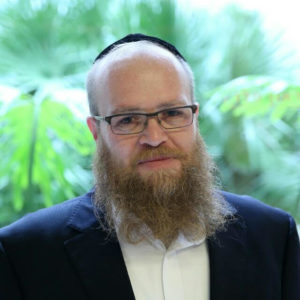

Chacham Shalom Cohen led his people with reverence and resolve
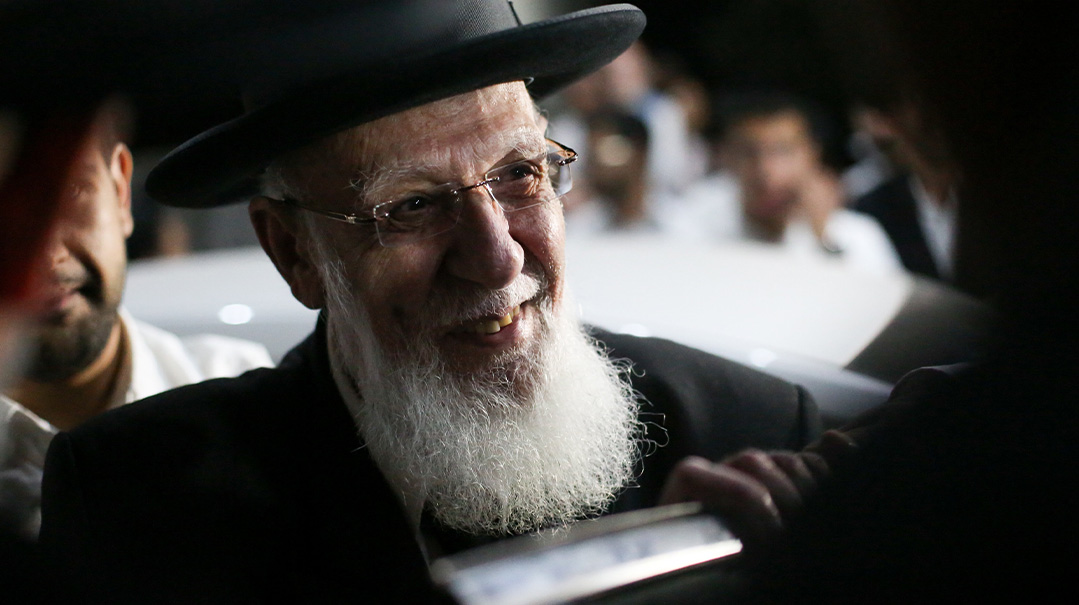
Photos: AEGedolim, Mattis Goldberg, Mishpacha archives
Every day, for more than five decades, a bystander in the lower part of Jerusalem’s Old City would have seen the same thing.
Sometime around late morning, a figure in litvish rosh yeshivah garb, whose face spoke of the traditions of the lost world of Baghdad’s Torah centers, walked into the large building at the far left of the Kosel Plaza.
Entering the halls of Yeshivat Porat Yosef — the flagship of the Sephardic Torah world, established at the request of the Ben Ish Chai in the early 1900s — the rav would deliver his daily shiur.
Rain or shine, weekdays, Friday and Shabbos, his mastery of the entire Torah would be laid out for the next generation of bochurim.
Last week, that seemingly timeless journey came to an end. Chacham Shalom Cohen, the preeminent rosh yeshivah of the Sephardi world, was niftar at age 91.
While those bystanders would have known that the Rosh Yeshivah was also the spiritual leader of the Shas party after the passing of Rav Ovadiah Yosef, most would have had no idea of his quiet revolutionary nature.
Because Chacham Shalom Cohen was not just Rav Ovadiah’s heir at the head of the movement to restore Sephardic Jewry’s traditional glory. He was actually the founder, the first mover; yet he’d been content to stay in the background for decades, while Rav Ovadiah was the face of the revolution.
Where Rav Ovadiah Yosef was amami — able to connect to the hundreds of thousands of simple folk — Chacham Shalom was the next stage of the Torah revolution: close to Rav Shach, leader of the Sephardi yeshivah world, he was intent on bringing the exacting standards of Porat Yosef to the generation educated in Shas’s schools and yeshivos.
Very different personalities, the two leaders of the Sephardic renaissance were close. Before the passing of Rav Ovadiah, he asked his family to call Chacham Shalom to the hospital. When the latter entered the room, Rav Ovadiah grabbed his hands and tearfully told him, “I love you. Know that I will never forget what you did for me. Not in this world and not in the world to come.”
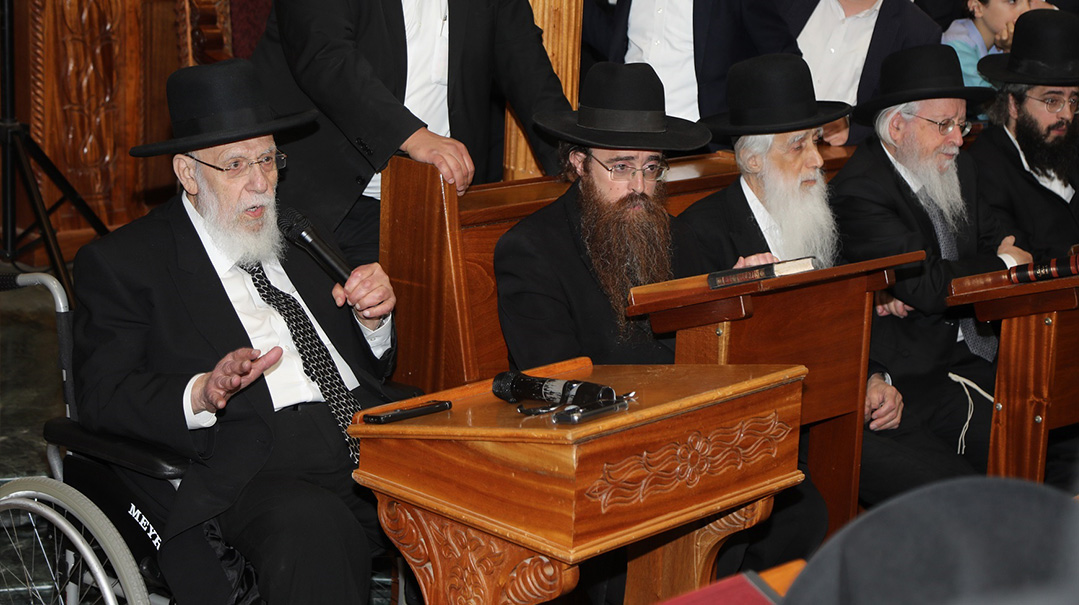
Until his final days, nothing could stop Chacham Shalom Cohen from teaching Torah
The Greatest Privilege
Chacham Shalom Cohen was, almost literally, born into the yeshivah that he went on to lead.
Shalom Cohen was born in Jerusalem in October 1931, one of ten children of Rav Efraim HaKohein, a noted Sephardi mekubal who immigrated to Eretz Yisrael in 1924 from Baghdad, where he had been a talmid of the Ben Ish Chai. (Seven of Rav Efraim’s children died in childhood in Iraq.) The year Chacham Shalom was born, his father was appointed to the staff of Yeshivat Porat Yosef in Jerusalem’s Old City alongside Rav Ezra Attiyah, and the family took up residence in the yeshivah.
Yet for Chacham Shalom, greatness wasn’t merely inherited — it came with lots of hard work.
Rav Shalom began studying at the yeshivah when he was 13, and although he was young, he developed a reputation as a brilliant ben Torah. He became close with Rav Ezra Attiyah, Rav Yehuda Tzadka and Rav Ben Tzion Abba Shaul, and often studied with his childhood friend Rav Ovadiah Yosef, although Rav Ovadiah was a decade his senior.
But even before his bar mitzvah, he and his classmates would memorize entire tractates, and even succeeded in winning a “pin test” on the masechta they were learning, given by one of the Yerushalmi gedolim of the time. (In a pin test, a pin is inserted into a word on an amud in Shas, and the person can tell you what’s on the other side of the amud in that very spot.)
“That’s how we learned,” Chacham Shalom said in a wide-ranging interview with Mishpacha after his appointment as nasi of the Sephardi Moetzet Chachmei HaTorah in 2014. “It was like we had a photocopier in our heads.”
He married Rabbanit Yael, daughter of Rav Mansour Ben Shimon, a mekubal from Tzfas who also taught at Porat Yosef.
Despite his young age, Chacham Shalom began delivering shiurim at Porat Yosef after his wedding. A few years before, during the War of Independence, the Jewish Quarter fell into the hands of the Jordanians, and the students were forced to flee. The yeshivah building was destroyed and its students dispersed into various shuls around Jerusalem, eventually finding a new home at the corner of Malchei Yisrael street in the Geula neighborhood, where Chacham Shalom was appointed rosh yeshivah in 1966 (and which still functions as a branch).
Chacham Shalom and Rabbanit Yael had eight children, whom they initially raised in a tiny two-bedroom apartment in Jerusalem’s Katamon neighborhood, where another branch of the yeshivah was established.
“For them it was a palace,” said a family member. “A room for the parents and a room for the children. What more does one need?”
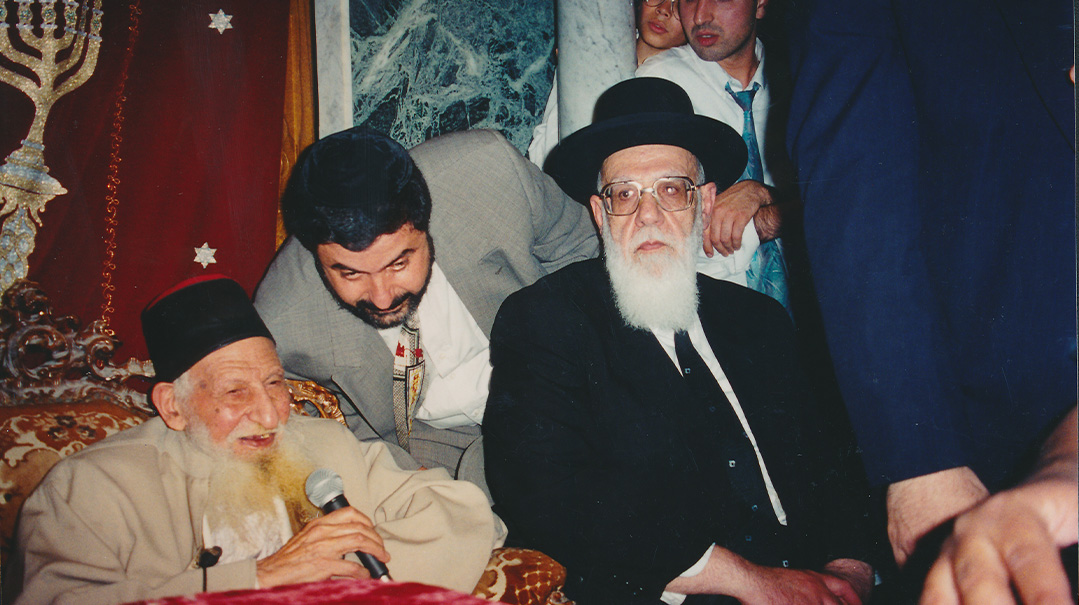
With Rav Yitzchak Kadouri
After the liberation of the Old City in 1967, the Porat Yosef yeshivah was rebuilt there, and the family too moved back. (Although Chacham Shalom was a venerated rosh yeshivah and head of the Council of Torah Sages, the family’s home was simple and sparse, except for the hundreds of books filling the living room shelves. In fact, until a few years ago, he insisted on walking unaccompanied — “I know my way home,” he would say — and would take public buses, until those close to him convinced him that it wasn’t appropriate for a rav of his stature.)
In 1984, Chacham Shalom agreed to Rav Ovadiah Yosef’s request to serve on the newly formed Moetzet Chachmei HaTorah of Shas. In April 2014, six months after Chacham Ovadiah’s petirah, Chacham Shalom succeeded him as nasi of the Moetzet.
But despite the honor thrust upon him, he always retained his trademark humility. A few years back, a group of newly installed Rabbanut dayanim headed to the Old City to receive the blessing of Chacham Shalom, and he shared with them a story that helped him keep his own focus. He told them about the time he visited the beis din of the Rabbanut as a young rav, to witness a din Torah. The av beis din, Rav Avraham Shapira, disagreed with the psak of his fellow dayanim and made his position clear. His colleagues, Chacham Salman Chugi Abboudi and Rav Yosef Cohen, refused to give in — and no psak was handed down that day.
The next day, Rav Shapira came to the yeshivah to search out young Rav Shalom Cohen, a joyous expression on his face.
“Last night,” Rav Shapira told him, “I went to ask Rav Tzvi Pesach Frank who had ruled correctly, and he concurred with the others. I was wrong. We have a psak!”
Chacham Shalom looked at the newly crowned dayanim and explained, “When you have the pure yirat Shamayim to cherish truth that way, you merit siyata d’Shmaya as well.”
Despite his public position, Chacham Shalom never considered leaving his post as rosh yeshivah. He was first and foremost a Torah scholar and educator of thousands. Rav Shach once said of him, “Rav Shalom’s Torah and yiras Shamayim are like a crown upon his head.”
“It’s a great privilege to be able to continue to teach Torah,” Chacham Shalom told Mishpacha. “And I can tell you that every student who studied with me still keeps in touch with me — I remember each and every one of them.”
His first rule of chinuch was always to set his own example, and never waste time. According to family members, he never raised his voice to scold his children, but they learned early on what was expected of them.
“The personal example,” one family member said, “is what steered us on the right path. Abba would tell us that if we didn’t have the koach to learn Torah, at least we should do something else useful. The main thing was that we shouldn’t waste time.”
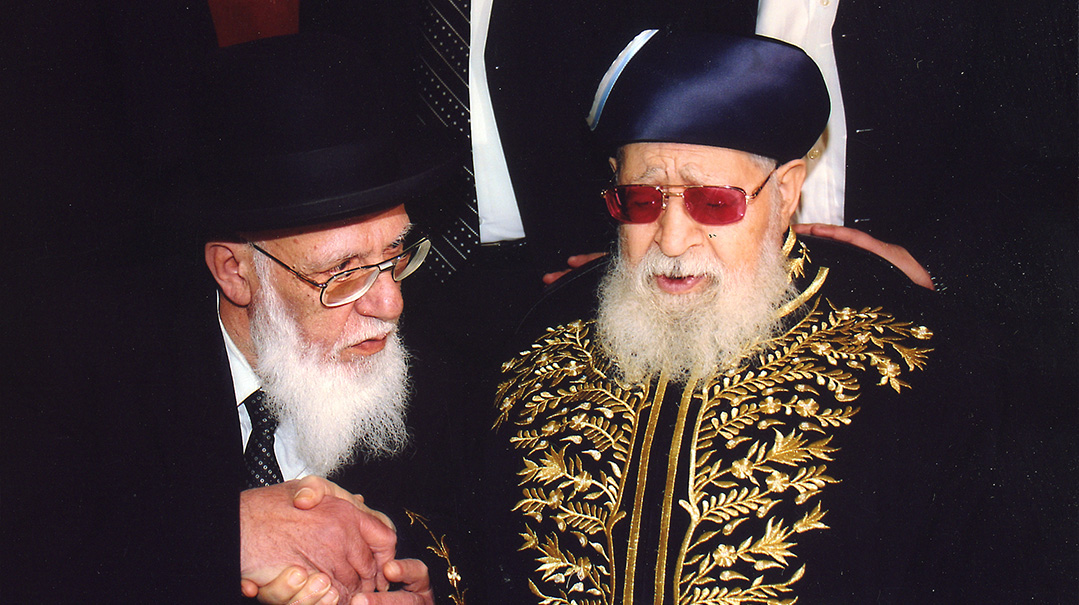
With Rav Ovadiah Yosef
No Formula for Tears
Chacham Shalom’s disciples and admirers are already thinking about the tefillos of the upcoming Yamim Noraim, and wondering how they’ll manage without the traditional davening of their rebbi. Because for decades, the davening at Porat Yosef has been synonymous with the rosh yeshivah, Chacham Shalom Cohen.
In the yeshivah, Chacham Shalom was never viewed as a baal tefillah, but as “the Rosh Yeshivah who davens.” For decades, it was the Rosh Yeshivah who was entrusted with the congregation’s prayers, not only opening hearts with his sweet voice, but also transporting their tefillos and tears straight to HaKadosh Baruch Hu’s treasury. That’s one reason so many avreichim, some of whom aren’t even former students, make sure to daven at the yeshivah every year.
In accordance with the custom of Sephardic congregations, Shacharit on the first day of Rosh Hashanah begins before dawn with the recitation of additional prayers, Pesukei D’zimra is recited in a whisper until Nishmat, and Shemoneh Esreh is recited at sunrise. And then, when the aron opened for the Torah reading, Chacham Shalom would stand before the massive aron kodesh and intone twelve times the prayer composed by the holy Rashash — a tefillah filled with mystical kavanos that has the power to forestall bitter decrees.
During Mussaf, the Rosh Yeshivah would weep constantly, and while some astute talmidim would try to figure out exactly which words caused their rebbi to shed copious tears, they never could. No one could figure out the formula for the Rosh Yeshivah’s tears.
The culmination of Chacham Shalom’s avodah was on Yom Kippur, and just like the Kohein Gadol of old, this Kohein too was clad in white from head to toe. And through the wide windows of the beit medrash, mispallelim can look out at the sight of the Kodesh Hakodoshim lying abandoned and disgraced, melding with the Rosh Yeshivah’s own tears.
One year after Yom Kippur, as the tzibbur exited the yeshivah to recite Kiddush Levanah, someone burst into the song “Mareh Kohein,” and everyone else joined in. But a second later, the Rosh Yeshivah silenced them with the admonition that there is no one worthy of that song, and especially not him. From that time on, the talmidim didn’t dare sing it in front of their rosh yeshivah, although he was the most venerated and holy Kohein they knew.
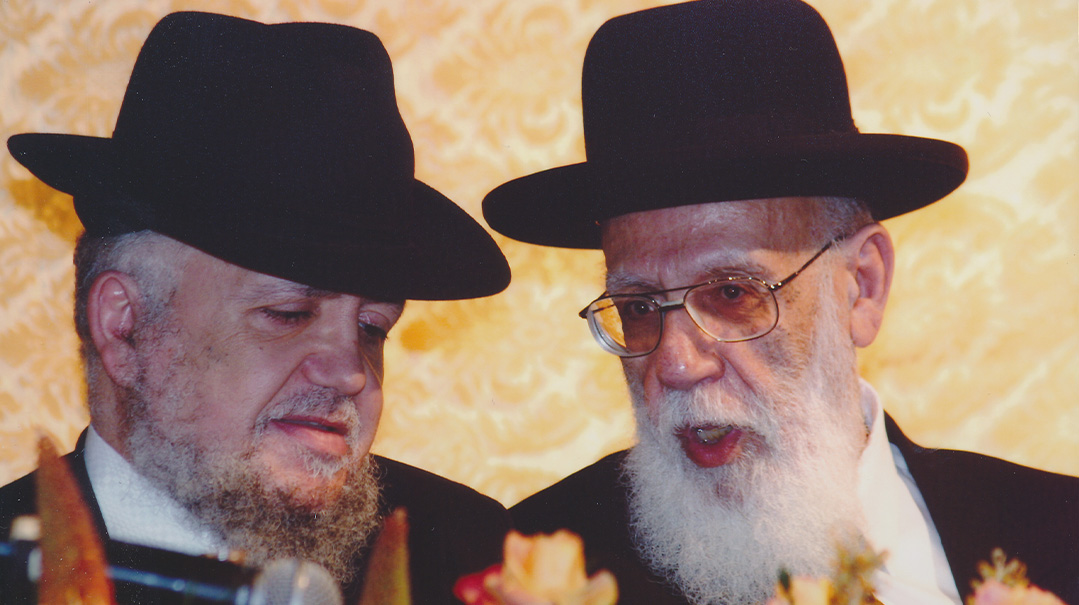
With Rav Meir Mazouz
Behind the Scenes
It was an overwhelming sense of responsibility for the vast numbers of Jews distant from their heritage that drew the Rosh Yeshivah from his beloved beis medrash to social action. A Shas Knesset member who used to visit Chacham Shalom’s home and give reports of their work knew that Chacham Shalom always greeted them with the question: “What have you done for Am Yisrael? What have you done today for the Torah?”
The public face of the Shas movement — founded in 1982 to restore Sephardic Jewry’s heritage — was Rav Ovadiah Yosef. But it was, in fact, Porat Yosef’s rosh yeshivah who persuaded the Sephardic chief rabbi to lead the movement.
At first, Rav Ovadiah argued that Sepahrdic Jews should continue to be a part of Agudas Yisrael, but Chacham Shalom Cohen believed that the establishment of a Sephardic Torah movement was the need of the hour. He declared that if he was joined by another rav from the Sephardic community, he would establish the movement. And immediately, he was joined by rosh yeshivah Rav Shabtai Atoun — two unknown warriors who began the Shas movement, which would later become a linchpin in almost every future government.
In its early days, Shas had many opponents. Some people didn’t like the initiative, and they turned to Rav Shach to exert his influence over Chacham Shalom, with whom he was close. But the Ponevezh rosh yeshivah thought otherwise. He saw the establishment of the Shas movement as a timely imperative and publicly threw his weight behind Chacham Shalom, whom he trusted implicitly.
“I didn’t make a move without Rav Shach. I asked for him opinion on everything,” Chacham Shalom told Mishpacha. “I would always consult with him. There were times when I would come to a simchah and he would be there, and he would rise from his place and come to talk to me. I would often go to Bnei Brak — sometimes even twice a day, to receive his blessing for various moves and initiatives.
“When I initially founded Shas, rabbanim who opposed the establishment of the movement came to Rav Shach and tried to persuade him to order me to retract my decision. He replied, ‘Are you familiar with Kiryat Yovel [a Jerusalem neighborhood with a large Sephardi population]? There are so, so many Jews there who need to be brought closer to Yiddishkeit. Who will do that, Agudas Yisrael? Everyone there is Sephardi, who’s looking at them?’ And that’s really how we started.”
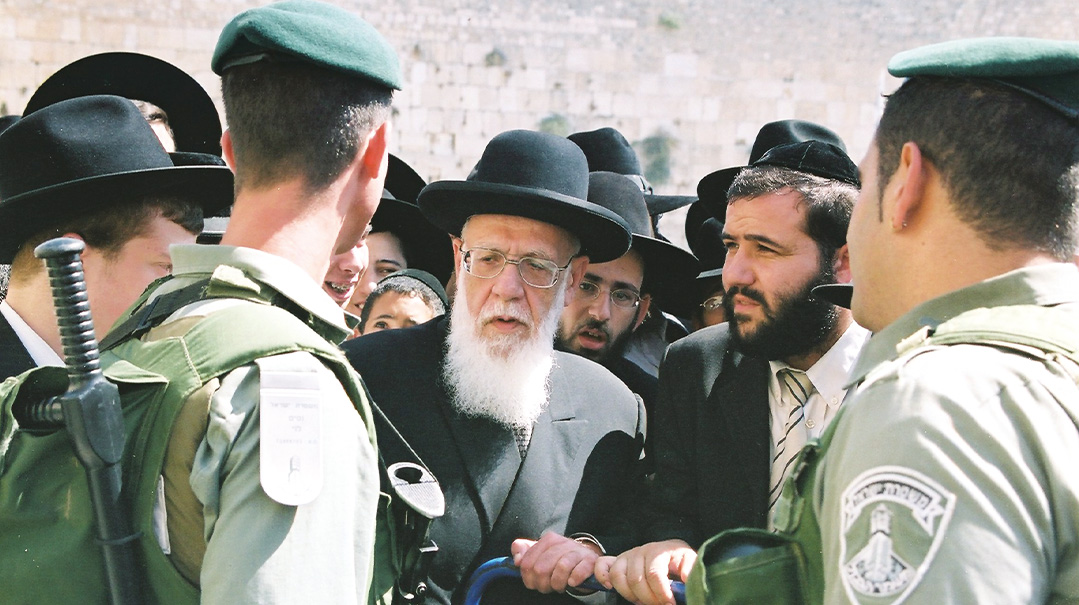
“So many Jews need to be brought closer to Yiddishkeit. Who will do that?” Chacham Shalom answered his own question when he founded Shas against the odds
The Shas movement began its public journey as an urban platform, when it first ran in the local elections for the Jerusalem municipality. Shas, headed by Rabbi Nissim Ze’ev, received three mandates in the elections and began negotiations with elected mayor Teddy Kollek. Right before the signing, Chacham Shalom, known for his zealousness when it comes to matters of Torah and halachah, learned that Kollek was about to sign a coalition agreement with the leftist, antireligious Meretz faction as well, and feared the consequences of a union with a faction that championed the war against “religious coercion.” He ordered the Shas representatives to abandon the negotiations and settle in the opposition.
In the new movement, not everyone liked the uncompromising position. Some of the new council members wanted the positions promised to them and waged a campaign to pressure the Rosh Yeshivah to remove the veto he had imposed on Shas representatives.
A year after the municipal elections in 1984, elections were held for the 11th Knesset, and Shas decided to compete in the national arena. Rav Ovadiah Yosef became the face of the movement, after Chacham Shalom consulted with Rav Shach, who recommended that Rav Ovadiah take the public reins. In tandem with Rav Ovadiah’s leadership, Chacham Shalom continued to be involved with the movement that he’d founded, but now it was behind the scenes, away from public scrutiny but within consulting range of Rav Ovadiah, who didn’t make a move without him.
“He is a man of truth, and all his words are for the sake of Heaven,” Rav Ovadiah would say about his trusted colleague.
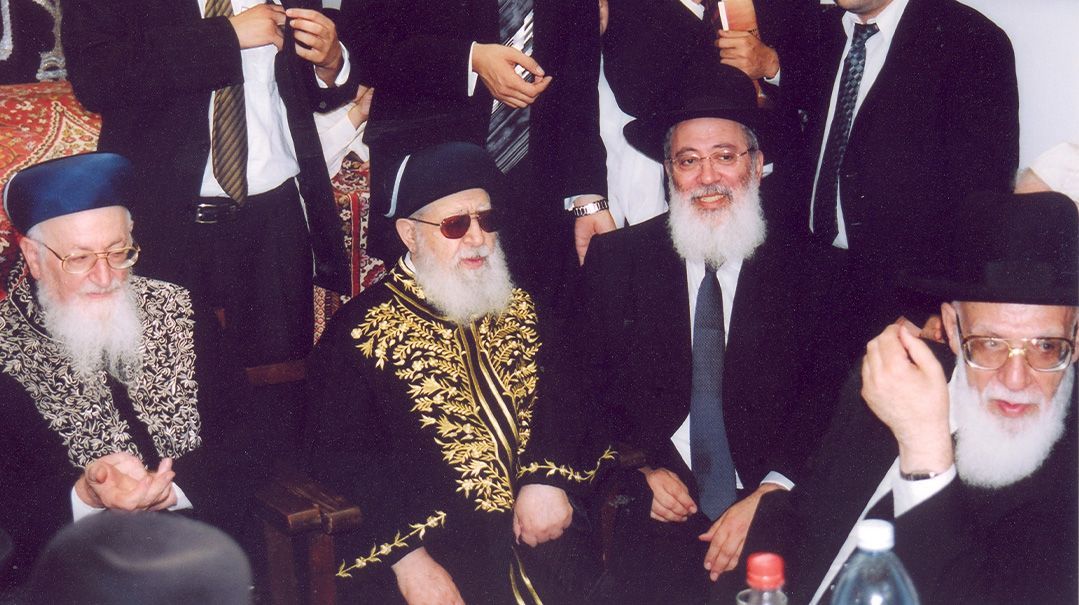
“When you have pure yirat Shamayim, you merit siyata d’Shmaya in rendering halachah.” (L to R) Rav Mordechai Eliyahu, Rav Ovadiah Yosef, Rav Shlomo Amar shlita and Rav Shalom Cohen
First a Rosh Yeshivah
Under Chacham Shalom’s leadership after Rav Ovadiah’s passing, the public face of Shas changed. Reflecting the massive growth of a generation of bnei Torah within the Sephardi Torah world — due in large part to Shas’s success — the party turned to cultivate that electorate, and the party’s Knesset representation reflected that re-orientation. Gone were the farmers from northern and central towns, and those who’d served as officers in the IDF: Today’s MKs are more likely to have spent time in kollel.
Since Chacham Shalom assumed the presidency of the Moetzet Chachmei HaTorah, large constituencies had returned to support and align with Shas. With the outspoken Rosh Yeshivah at the helm, they no longer needed to look for another political home.
While through the back door Shas is losing the support of the traditional public, its spiritual leader made great strides into the heart of the Torah Sephardic mainstream.
But despite his major role in Israeli national life in the last nine years of his life, Chacham Shalom remained first and foremost a rosh yeshivah.
His public activity and frequent preoccupation with the affairs of the Moetzet never crossed over into his preoccupation with the Torah. When he was in a yeshivah with his students, he would not mention, or even hint to, any trace of his public or political activities if it wasn’t directly related to the study and lifestyle of a Torah scholar.
Shas chairman Aryeh Deri, who became especially close to Chacham Shalom in the last decade, echoed Rav Ovadiah’s long-ago proclamation about his friend Chacham Shalom as “a man of truth whose words are only for the sake of Heaven.”
“It was so true,” a teary Deri said at the levayah. “He lived his life without any vested interests. Not family, not friends, only truth until the end. With love, with compassion, but only truth nonetheless. He was a banner of truth in a tainted world.”
(Originally featured in Mishpacha, Issue 925)
Oops! We could not locate your form.







